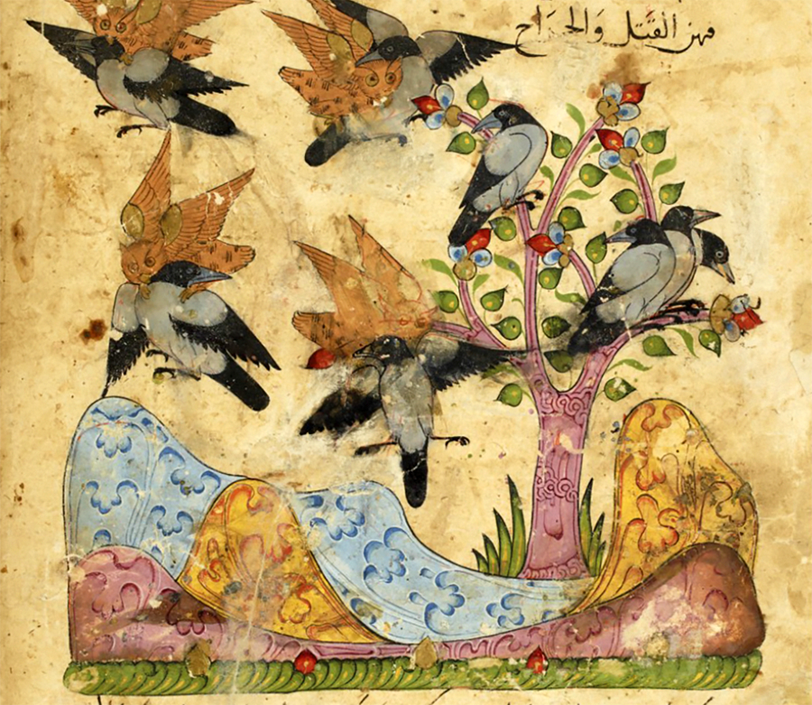What is Kalīla and Dimna?
Kalīla and Dimna is one of the most widespread and influential books in the history of humanity. A collection of tales teaching political wisdom, it transcended languages, cultures and religions. Throughout the centuries, the book travelled from India via across the Middle East to Europe and beyond. In its course, it was transferred from Sanskrit via Middle Persian and Arabic to Syriac, Greek, Hebrew, Latin (under the title Directorium vitae humanae), and most European vernaculars, as well as Near Eastern, South Asian and South-East Asian languages. Its religious and social context changed from Hinduism via Zoroastrianism to Islam, and from there to Christianity. Kalīla and Dimna is one of the first Arabic books to reflect its own epistemology. It also is considered the first secular fiction in the Arabic language.
Decoding
The extant versions of Kalīla and Dimna cannot be reduced to a single text. Aiming at a digital edition, the project has broken new ground in two ways. First, it acknowledged the many Arabic versions in their diversity as coexisting texts, and investigated them for the different aspects emphasized, such as literary vs. popular idiom, the function of entertainment vs. political guidance.
The innovative approach tackled the problematic state of the sources that so far prevented a conventional (stemmatic) critical edition, by establishing parallel representative versions of the text. Through digital means the diverging manuscripts could be compared on the different levels of plot structure as well as the formulation of plot elements. The digital tools allowed to chart the text’s metamorphosis without reduction or simplification toward a better understanding of its multifaceted simultaneity.
Encoding
The work’s very success has made its study complex due to the emergence of multiple versions. The circa one hundred extant Arabic manuscripts (dating from the thirteenth century onwards) and the earlier fragmentary indirect transmission (ninth to eleventh centuries) vary far beyond of what is known in classical Arabic literature. The European translations represent yet further strands. Whereas such variance is common in popular literature, Kalīla and Dimna by its high literary idiom clearly belongs to the classical Arabic canon. To date, the Arabic versions remain without a proper critical edition whereas in Europe Kalīla and Dimna is largely unknown today.
E-Learning and E-Teaching
Because of its modular structure and its large variety of linguistic and stylistic registers and the conveying of ethical messages through animal fables, the chapters of Kalīla and Dimna are especially apt for the training of Arabic manuscript reading, transcription and translation skills. A test run of an e-learning pilot concept has been carried out within the bachelor's curriculum of Arabic Studies at Freie Universität Berlin. Students were offered the opportunity to work on part of a manuscript in their own time, tutored in regular intervals by the faculty’s academic staff. At the same time they used the digital synoptic edition of one chapter for in class discussion of the variants and then composed their own synoptic edition out of the digitised manuscripts. Via new digital work flows, students may thus be integrated in text editing projects at a very early stage in their academic careers, and their achievements will be credited and made public as part of the Digital Humanities project on Kalīla and Dimna.
E-Learning project @ CeDiS
At Freie Universität Berlin, Beatrice Gruendler (Arabic Studies) and Brigitte Grote (CeDiS) have co-directed the e-learning project based on Kalīla und Dimna manuscripts and text variants: Kalīla und Dimna – Weisheit kodiert (Kalīla und Dimna – Wisdom Encoded). This project was one of the conceptual pilots for the ERC Advanced Grant AnonymClassic (2018–2022) led by Beatrice Gruendler.


